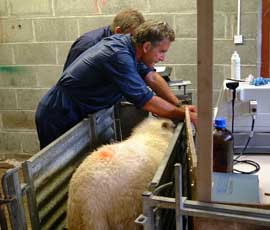Subsidised barren ewe test available

Farmers worried about barren ewes amid fears of Schmallenberg infection can take advantage of a subsidised diagnostic service.
Producers with a barren rate greater than 2% can ask for a subsidised flock blood test to establish whether the cause of the problem is toxoplasmosis.
Barren EweCheck – the diagnostic scheme supported by MSD Animal Health – is available from vets until 31 March 2013. Producers concerned about flock SBV infection and empty or aborting ewes should talk to their vet about the service as soon as possible.
Toxoplasmosis is the main infectious cause of early embryo loss in sheep and a very common cause of barrenness, abortion and weak lambs born alive. Data from the 2012 Barren EweCheck scheme showed that 83% of the flocks tested had been exposed to the toxoplasma parasite.
“Sheep producers are rightly concerned about SBV at the moment, but it is important to understand that other disease problems could well be at the root of a poor scanning result,” points out vet Drew McGurren from MSD Animal Health.
“For example, toxoplasma is an environmental contaminant spread by infected cats. This means all flocks are at risk, because it only takes one brief visit by an infected cat to contaminate the whole farm. The good news is that where toxoplasma infection has been confirmed in a flock, the disease can be controlled effectively by a vaccination regime. What’s more, the costs of a prevention programme can be easily covered by a reduction in future flock barren rates.”
Shortly, MSD Animal Health will also launch its annual FlockCheck diagnostic service, which will run until the end of July 2013. This requires vets to take blood samples from six to eight aborting ewes.
“The 2012 FlockCheck results showed once again that the most commonly diagnosed causes of abortion in sheep continue to be enzootic abortion (EAE) and toxoplasmosis, despite the availability of cost-effective vaccines,” says Mr McGurren.
“More than 300 samples were tested in 2012, of which 86% were positive for toxoplasmosis and 58% for EAE. More than 50% of the samples showed exposure to both these diseases.”
Find out more about toxoplasmosis and how to prevent it in your flock
Help us build a picture of lamb losses in your area by filling out a short online survey
